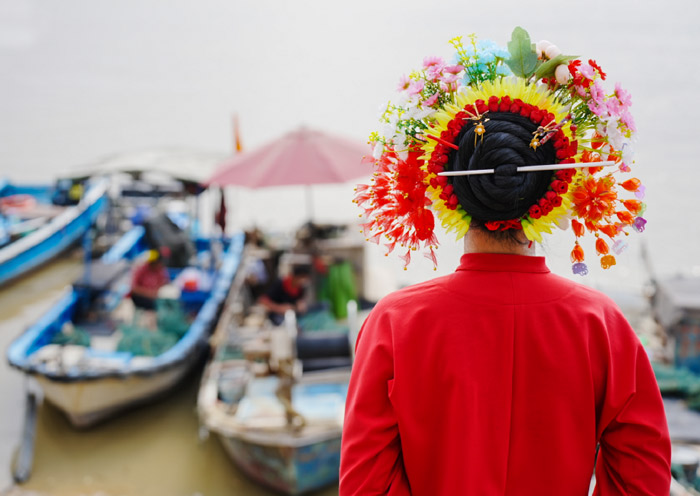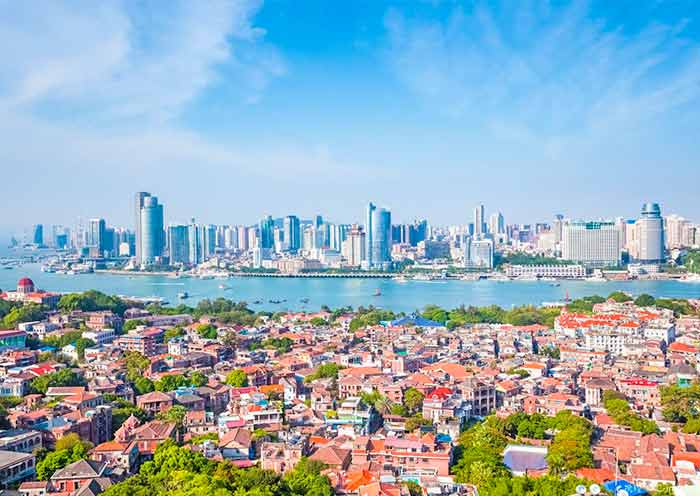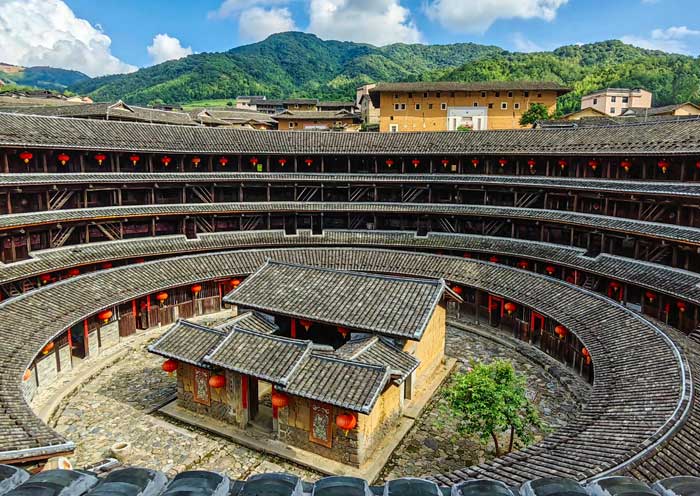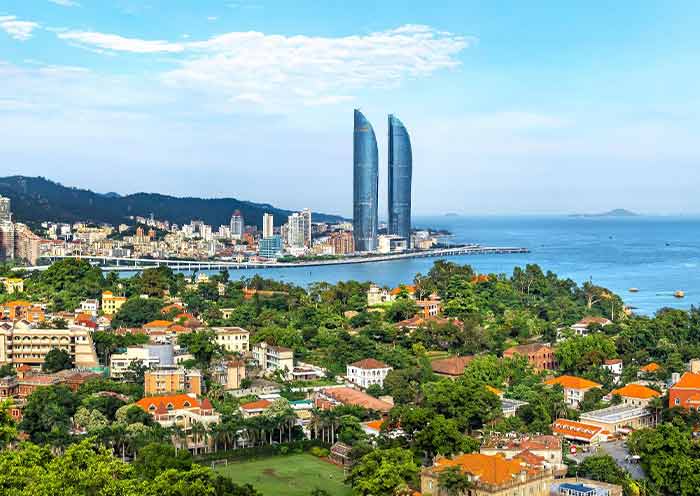I did a 2-week tour in China, in Dec24/Jan25 and I was very pleased with Asia Odyssey. They handled everything very professionally, from the good accommodations to the great tour guides we had. I totally recommend this company for China tours.
Fujian Quanzhou Tour - Best China Quanzhou Tours 2025
Why China Fujian Quanzhou Tour? Located on the southeast coast of Fujian province, Quanzhou was the largest port in Asia during the Song (960-1279) and Yuan (1271-1368) dynasties. Take our China Quanzhou Tours, you can gain a better understanding of why Quanzhou is famous as the Museum of World Religions and why Zaiton (Zayton), the old name of Quanzhou, was renowned outside of China. Hailed as "The City of Light" by Jacob D'Ancona and marked by Marco Polo as "The Most Prosperous City in the World," Quanzhou was the starting point of the Maritime Silk Road, which facilitated trade links and cultural exchanges with nearly 100 countries and regions. With a China Quanzhou tour, you will see Foreign traders also brought their beliefs, making Quanzhou a city where you can witness the peaceful coexistence of Taoism, Buddhism, Islam, Catholicism, Hinduism, Christianity, Manichaeism, and Judaism.
As the hometown of overseas Chinese, Quanzhou is also a top destination for people of Chinese origin to reconnect with their ancestral roots. Take a Quanzhou tour to immerse yourself in the local Hokkien culture by experiencing Minnan architecture, savoring delicious Minnan food, and enjoying local Hokkien songs like "Put in the Effort, You Will Win" (爱拼才会赢). As the 56th World Heritage Site of China and a history of over 1,000 years, Quanzhou is a must-visit city for you to learn more about China and its culture.
How to plan your Fujian Quanzhou Tours?
1 Day Quanzhou Tour From Xiamen: Follow Marco Polo & Explore The City of Light
Visit: Kaiyuan Temple, West Street, Zhongshan Road, Quanzhou Confucian Temple, Tumen Street, Qingjing Mosque, Guandi Temple, Mazu Temple, Luoyang Bridge (optional 1) or Xunpu Village (optional 2)
2 Days Quanzhou In-depth Tour: Back to Zayton - Starting Point of The Maritime Silk Road
Visit: Kaiyuan Temple, West Street, Zhongshan Road, Quanzhou Confucian Temple, Tumen Street, Qingjing Mosque, Guandi Temple, Mazu Temple, Luoyang Bridge (optional), Qingyuan Mountain, Quanzhou Maritime Museum, Holy Tombs (optional), Xunpu Village
Extend Fujian Quanzhou Tours with Other Destinations in China:
You can extend your Quanzhou Tour to other destinations in Fujian such as Xiamen, Hakka Tulou, Wuyishan Mountain, or Xiapu. For a China Quanzhou Tour along with Shanghai, Xian, Beijing, the Greater Bay Area, or Tibet, contact us to customize it.

"Excellent Tour, best experience"
"A unique experience despite a difficult context thanks
to an experience team of organisers"
- 2 Best Fujian Quanzhou Tours
- 8 Recommended Fujian Tour Packages
- Articles & Planning
2 Best Fujian Quanzhou Tours
Immerse yourself in China's world heritage site of Quanzhou with a 1-day Quanzhou Tour from Xiamen and a 2-day Quanzhou In-depth Tour. Besides our 2 Best Fujian Quanzhou Tours, you can enjoy more Fujian tours, exploring the wonders of Quanzhou, Xiamen, Tulou, and Xiapu. Tailor your China Quanzhou tour to your preferences and discover the captivating highlights of Fujian at your own pace! Have fun in Quanzhou of China.
8 Recommended Fujian Tour Packages
Refreshing Fujian (清新福建), explore the Beauty of Fujian with memorable Fujian Tours to Xiamen, Tulou, Wuyishan, Quanzhou, or Xiapu. You will discover the coastal charm of Xiamen city, the amazing world cultural heritage site of Fujian Tulou, the majestic landscapes of Mt. Wuyishan (world natural and cultural heritage site), the historic city of Quanzhou (world cultural heritage site), or the mesmerizing beauty of Xiapu (photographer's heaven). Immerse yourself in the rich culture and natural wonders of Fujian with our expertly crafted tours. Book your China Fujian tour today and have an unforgettable journey through these remarkable destinations.
Quanzhou Tours Planning & Useful Articles
Quanzhou Tours FAQs - Plan Your Quanzhou Tours Worry-Free
-
 1. Why is Quanzhou named Zaiton?
1. Why is Quanzhou named Zaiton?
Quanzhou of Fujian province is believed to be named Zaiton due to its pronunciation in Arabic and Persian languages during the medieval period. The name Zaiton is derived from the Arabic word "Zaytun," which means "Erythrina tree." It is said that the city was called Zaiton due to the abundance of Erythrina trees in the region during ancient times. Over time, the name Zaiton evolved into Quanzhou of China as the city's name in Chinese.
-
 2. What did Marco Polo say about Quanzhou?
2. What did Marco Polo say about Quanzhou?
Marco Polo, the famous Venetian explorer, visited Quanzhou of Fujian Province during the 13th century and described it as "The Most Prosperous City in the World." In his travel accounts, Marco Polo praised China Quanzhou for its bustling trade, extensive markets, and wealth. He marveled at the city's vibrant economy, diverse population, and the grandeur of its temples and palaces. Marco Polo's account of Quanzhou contributed to its reputation as a prosperous and cosmopolitan trading hub during that era.
-
 3. What is Quanzhou best known for?
3. What is Quanzhou best known for?
Quanzhou of Fujian provinceis best known for its historical role in maritime trade, its cultural diversity and religious tolerance, its architectural heritage, and its connection to the Maritime Silk Road. Here are several aspects about Quanzhou:
1). Maritime Trade: Quanzhou was the largest port in Asia during the Song (960-1279) and Yuan (1271-1368) dynasties. It played a significant role as the starting point of the Maritime Silk Road, facilitating trade and cultural exchange with regions such as Southeast Asia , Persia, Arabia, and Africa.
2). World Religions: Quanzhou of China is often referred to as the "Museum of World Religions" due to the coexistence of various religions within the city. Taoism, Buddhism, Islam, Catholicism, Hinduism, Christianity, Manichaeism, and Judaism have all left their mark on Quanzhou's cultural landscape.
3). Historical and Cultural Heritage: Quanzhou boasts a rich historical and cultural heritage. The city preserves ancient architecture, including temples, mosques, pagodas, and ancestral halls. It is renowned for its stone-carved cultural relics, such as inscriptions and statues.
4). Ancestral Roots: Quanzhou is considered the hometown of many overseas Chinese, and it holds significance for people of Chinese origin seeking to reconnect with their ancestral roots. Many people visit Quanzhou to explore their family history and genealogy.
5). Hokkien Culture: Quanzhou is a hub of Hokkien (Minnan) culture. It is known for its distinctive Hokkien architecture, which features elegant courtyard houses, temples, and ancestral halls. The city is also famous for its delicious Hokkien cuisine, known for its fresh seafood and unique flavors.
-
 4. What religions can be found in Quanzhou?
4. What religions can be found in Quanzhou?
Quanzhou of Fujian province is known for its religious diversity and the coexistence of various faiths. The coexistence of these religions in China Quanzhou is a testament to the city's cultural openness and religious tolerance throughout its history. The city is home to several religions, including:
1). Taoism: Quanzhou has a significant presence of Taoist temples and practitioners. Taoism is an indigenous Chinese religion that emphasizes harmony with nature and the pursuit of spiritual enlightenment.
2). Buddhism: Buddhism has a long history in Quanzhou of China, and there are numerous Buddhist temples and monasteries in the city. Buddhist teachings and practices have influenced the local culture and traditions.
3). Islam: Quanzhou has a sizable Muslim population, and there are several mosques in the city. Islam was introduced to Quanzhou during the Tang Dynasty and has since become an integral part of the city's religious landscape.
4). Catholicism: Quanzhou has a Catholic community with several Catholic churches and institutions. Catholicism was introduced to Quanzhou by foreign missionaries during the Yuan Dynasty and has a long history in the city.
5). Hinduism: Quanzhou has a small Hindu community, primarily consisting of overseas Indian residents. Hindu temples exist in the city, serving the religious needs of the local Hindu population.
6). Christianity: Quanzhou has a Christian presence, including both Protestant and Catholic denominations. Christian churches can be found in the city, and the faith has followers among the local population.
7). Manichaeism and Judaism: Historically, Quanzhou had communities practicing Manichaeism and Judaism. While their presence is not as prominent today, traces of their influence can still be found in the city's history and cultural heritage.
-
 5. How do you get to Quanzhou? Are there an airport and high-speed train to Quanzhou?
5. How do you get to Quanzhou? Are there an airport and high-speed train to Quanzhou?
Quanzhou of Fujian province is well-connected and can be reached by various modes of transportation. Here's how you can get to Quanzhou of China:
1). Get to Quanzhou By Air: Quanzhou Jinjiang Airport (JJN) serves as the primary airport for the city. It offers domestic and international flights, making it convenient for travelers to reach China Quanzhou by air. From the airport, you can take a taxi or use public transportation to reach your destination within the city.
2). Get to Quanzhou By High Speed Train: Quanzhou has a railway station called Quanzhou Railway Station, which is connected to the national rail network. Bullet trains operate to and from Quanzhou, providing convenient access from major cities in China, including Beijing, Shanghai, Guangzhou (Guangdong province), and Xiamen. The railway station is located in the downtown area, making it easily accessible for travelers.
Once you arrive in Quanzhou, you can use local transportation options such as taxis, buses, and local minibusses to get around the city and explore its attractions.
-
 6. Why is Quanzhou named the City of Light?
6. Why is Quanzhou named the City of Light?
Quanzhou of Fujian province is often referred to as the "City of Light" due to its historical significance as a prosperous trading port that attracted merchants from around the world. The name reflects the city's vibrant economic activity and the cultural diversity resulting from international interactions.
During the Song (960-1279) and Yuan (1271-1368) dynasties, China Quanzhou flourished as a major center of maritime trade along the Maritime Silk Road. The city was a bustling hub of commerce, attracting merchants from different countries and regions. This thriving trade brought wealth, cultural exchange, and knowledge to Quanzhou, making it a beacon of prosperity and enlightenment.
Also, the answer can be found in Jacob d'Ancona's description in "The City of Light": "Because the streets are filled with so many oil lamps and torches, the city shines brilliantly at night. It can be seen from afar. For this reason, people call Quanzhou the City of Light."
-
 7. What is the Maritime Silk Road? Why was Quanzhou so important?
7. What is the Maritime Silk Road? Why was Quanzhou so important?
The Maritime Silk Road refers to a network of maritime trade routes that connected various regions and civilizations across the Indian Ocean and the South China Sea. It was an extension of the overland Silk Road and played a crucial role in promoting trade, cultural exchange, and diplomatic relations between different civilizations. As the starting point of Maritime Silk Road, China Quanzhou (Fujian Province) was important because of its location, developed port infrastructure, economic prosperity, cultural exchange, extensive trade networks, technological advancements, and religious heritage. It served as a crucial hub for trade, cultural exchange, and the diffusion of ideas along the Maritime Silk Road.
-
 8. Is Quanzhou worth a visit?
8. Is Quanzhou worth a visit?
Quanzhou of Fujian is worth visiting for its rich history, cultural heritage, architectural marvels, delicious cuisine, natural beauty, and warm hospitality. As the 56th World Heritage Site of China, Quanzhou is a popular tourist city for its glorious past and bright future. In Quanzhou tour, you will have the opportunity to visit the 22 world heritage sites in Quanzhou, such as Kaiyuan Temple, Quanzhou Confucian Temple (closed on Mondays), Qingjing Mosque (Qingjing Temple), Tianhou Temple (Mazu Temple), Deji Gate Site (opposite Tianhou Temple), Luoyang Bridge, Laojun Rock Statue (in Qingyuan Mountain), and the Islamic Mausoleum (Holy Tombs).
-
 9. Why is Quanzhou compared to Xian, the starting point of the Silk Road?
9. Why is Quanzhou compared to Xian, the starting point of the Silk Road?
Xian and Quanzhou of Fujian are compared due to their historical significance in the Silk Road. While Xian was the starting point of the overland Silk Road, China Quanzhou was the starting point of the Maritime Silk Road. Both cities facilitated trade, cultural exchange, and left lasting legacies in terms of historical sites, architecture, and the diffusion of ideas and cultures.
Latest Quanzhou Tours Reviews from Our Customers

George
Romania
Destination(s): Beijing, Xian, Shanghai, Chengdu/Sichuan, Guilin/Yangshuo, YangtzeRiver
Date of Experience: Jan 01, 2025
Tour Customized by: Catherine
You May be Interested in This Tour: Customized Tour

Ilwad
Australia
Tour name: Line B2, 8 days Lhasa-Yamdroktso-Shigaste-Mt.Everest tour.
Key people: Bob (local Tibetan tour guide), Catherine Wang (travel consultant), Mr. Yu. Jian (driver).
This tour was sublime, a truly once-in-a-lifetime opportunity! From the very start, I was met with grace and incredible kindness. The driver assigned to me by the company was Susan and greeted me with a smile on her face, as well as the traditional Tibetan scarf she delicately placed around my neck. She then kindly offered to take some photos of me outside of the airport and offered me some water as we drove to the first accommodation in Lhasa. She then sent me a few locations within the city to explore, for shopping and food and shared her experience of living in the region for over a decade.
The following day we met our tour guide Bob, who to date has been my favourite tour guide. He was nothing short of incredible. Not only did he translate everything from Tibetan to Mandarin and English, making the tour accessible to all of us, but went above and beyond for all of us. Whether it was taking extra photos from awkward angles as the photographer to answering our follow-up questions or even giving us his own recommendations i.e. where to rent the traditional Tibetan clothes or shop for souvenirs. He was incredibly knowledgeable and humble- a true mix of wisdom and personal insight. I found his personal experiences and insight made the tour feel more authentic, especially as he had been doing this since 2009. His great anecdotes and true appreciation of the Tibetan culture, as well as his uplifting attitude and great sense of humour made the trip that much more special. Especially on the days when we were on the road for up to 7 hours, as we began the travel towards Everest Base Camp (EBC).
In terms of the people I met on the tour, it was truly a mixed bag in the best way possible! As I was a 22-year-old solo solo-female traveler you might expect that I would want to be around a similar company. In contrast, I had the best time ever with a wildly different demographic! From middle-aged interracial married couples to retired solo travelers and other solo travelers, my group was made up of people from different neighbouring countries each with their own experiences of travel. As someone who is learning Chinese this was perfect for improving my linguistic skills however most could also speak English so there were no language barriers either.
The people in my group were lovely, kind and interesting characters. Each with open-minds and curiousity about the Tibetan culture. Having people from different walks of life and experiences in my group turned out to be a blessing in disguise. Even with our different backgrounds, we shared laughter, food and stories. I am grateful to have been in the same group as them for those 8 days- it was a true pleasure. Also, the nature of the tour meant that we overlapped with different groups based on both of our itineraries, meaning that we mixed with others for the first few days of the tour. This was a great way to also meet others as some were also staying at the same hotel as us.
The driver Mr. Yu Jian was also incredible. He so kindly brought our luggage in and out of the vehicles and always waited for us patiently in the mornings. Even when we (I) were running late, losing track of the timings and rushing outside with a hastily prepared buffet breakfast to go.
In terms of the tour, my personal highlights were of course seeing EBC and Everest in person, however, the in-betweens were just as remarkable. The 108 zig-zags we had to endure on the way to EBC, the petrol station stops where we’d stretch our legs and interact with the locals (often trying to sell us things) and growing closer and closer to the enchanting Everest. Being able to see the surreal landscape views of Tibet, both in Lhasa and outside, was awe-inducing. As I flew in on 25/03, I was met with the mountainscape being submerged with snow. By the time we made it to EBC, the snow had mostly melted but the rugged mountain view perfectly complemented the seemingly endless holy Yamdrok Lake. It was a nature lover’s paradise through and through, especially with the domesticated and wild animals across the area.
I also thoroughly enjoyed interacting with the locals. They met me with such curiosity, warmth and open-mindedness. I was touched to be perhaps the first black European person they met, and hope that they left our interactions with a new perspective. The first meal I had in Tibet was also sublime (I will put a picture below of the dish and a screenshot of the location I went to, recommended to me by my first driver). There was also a traditional Tibetan musical performance shortly after I had finished my meal, also recommended to me by Susan which began around 8pm!
My favourite monastery we visited was also the Tashi Lhunpo monastery in Shigatse, which we visited on our penultimate day in Tibet. We went on a Sunday which meant that not many tourists, if any, were there. Especially the tour took place during the off-season (End of March/Early April). As such it was an immersive experience being able to calmly walk through the monastery. With a history dating back to 1447, I felt like I connected to this the most, with there being living trees on the site that had been first planted over 400 years ago! Even seeing locals re-paint some of the religious paintings and the monks ready to enter for their evening classes gave a sense of serenity. It was a wonderful way to end the trip. Also, I would like to highlight seeing the Yamdrok Lake’s deep shades of turquoise from many angles (extraordinary), trying yak meat for the first time (different and at times tasty), seeing the Karola glacier (even when the rest of the landscape was snowless), seeing monks’ daily debates at Sera Monastery, of course climbing and seeing Polata Palace (tip: bring a 50 RMB note with you to take the famed picture outside Polata Palace- a fellow tour member loaned me his, thanks Yuki!), as well as Jokhang Temple and the Tibetan incense making where the activity leader wrote us, upon our request, a sign in the Tibetan language with anything i.e. our name or quotes. Seeing the stars on the first day of the new moon in the village just outside of Everest was also phenomenal (tip: walk 5-10 minutes in the opposite direction of heading into town to escape the light pollution for a better view, we only stayed out for 15 minutes just around midnight due to fatigue but if you really commit to it and maybe even venture further out and perhaps later on in the night around the new moon phase you will be stunned out what will find in the starry night sky.. hopefully the milky way!).
I would also like to give a warm mention to the hotel workers in the first hotel we stayed in Lhasa as they were incredibly kind to me. They were curious to know what my story was and where I had travelled as well as catering to my needs in the mornings (i.e. morning coffee etc.). Though they won’t see this, the woman working at the Tibetan clothes’ rental who helped me take pictures on my phone and conversed with me was also very kind! Even the shopkeeper who gave me a freebie after I bought some goods from his store was patient with me as I perused through the shops looking for instant noodles. Overall, I was met with such kindness from the very start of the trip until the very end!
Regarding altitude sickness, the tour will provide you with one free bottle of oxygen, as well as an emergency tank of oxygen in the shuttle bus. For reference I didn’t finish the bottle of oxygen throughout the trip but bought a spare one from the supermarket down the road from the hotel in Lhasa and the quality was great for only a few more RMB (lasted the entire trip). With a lot of water for hydration and taking it easy, alongside deep breaths, I think this tour is accessible to anyone without any underlying health conditions.
Finally, I would like to thank my tour agent Catherine Wang who has supported me throughout this trip! From when I first sent an email back in December 2024 to inquire about this tour until present she has supported me and provided me with updates throughout this process. Although I sent persistent emails (regarding the Shigatse earthquake and permit process/progress update) she always kept me in the loop. Even during the trip she had sent me an email to ask how it was going. Thank you very much for your patience and hard work, this trip has been the trip of a lifetime!
TLDR: I would 1000% recommend this trip and tour. All the little moments and cherished memories I have made will last a lifetime. Thank you to Bob, Mr. Yu Jian, Catherine, Susan, my tour group members and all the others who have made this trip so special. I am beyond grateful.
Destination(s): Tibet
Date of Experience: Oct 07, 2024
Tour Customized by: Catherine
You May be Interested in This Tour: 8 Days Lhasa Yamdrok Shigatse Group Tour with Everest Base Camp

Siew Chor
Australia
Liz was prompt with her helpful response. We appreciate her help.
Destination(s): Beijing
Date of Experience: Oct 07, 2024
Tour Customized by: Liz
You May be Interested in This Tour: 4 Days Classic Beijing Tour with Forbidden City & Great Wall
- United States (+1)
- Australia (+61)
- Singapore (+65)
- Malaysia (+60)
- Philippines (+63)
- Canada (+1)
- Italy (+39)
- Indonesia (+62)
- United Kingdom (+44)
- Spain (+34)
- Mexico (+52)
- Hong Kong (+852)
- Thailand (+66)
- United Arab Emirates (+971)
- New Zealand (+64)
- South Africa (+27)
- Germany (+49)
- Brazil (+55)
- India (+91)
- France (+33)
- Vietnam (+84)
- The Netherlands (+31)
- Saudi Arabia (+966)
- Ireland (+353)
- Argentina (+54)
- Switzerland (+41)
- Romania (+40)
- Pakistan (+92)
- Japan (+81)
- Portugal (+351)
- Bangladesh (+880)
- South Korea (+82)
- Puerto Rico (+1)
- Türkiye (+90)
- China (+86)
- Belgium (+32)
- Qatar (+974)
- Greece (+30)
- Taiwan (+886)
- Austria (+43)
- Poland (+48)
- Israel (+972)
- Chile (+56)
- Sri Lanka (+94)
- Nigeria (+234)
- Peru (+51)
- Colombia (+57)
- Hungary (+36)
- Nepal (+977)
- Denmark (+45)
- Bulgaria (+359)
- Norway (+47)
- Slovenia (+383)
- Sweden (+46)
- Kuwait (+965)
- Costa Rica (+506)
- Ecuador (+593)
- Venezuela (+58)
- Malta (+356)
- Croatia (+385)
- Tunisia (+216)
- Czechia (+420)
- Mongolia (+976)
- Bahrain (+973)
- Mauritius (+230)
- Papua New Guinea (+675)
- Cambodia (+855)
- Dominican Republic (+1)
- Luxembourg (+352)
- Finland (+358)
- Guatemala (+502)
- Myanmar (+95)
- Maldives (+960)
- Slovakia (+421)
- Laos (+856)
- Serbia (+381)
- Brunei (+673)
- Oman (+968)
- Macao (+853)
- Panama (+507)
- Morocco (+212)
- Jordan (+962)
- Georgia (+995)
- Fiji (+679)
- Bolivia (+591)
- Lithuania (+370)
- Bahamas (+1)
- Cyprus (+357)
- Latvia (+371)
- Bhutan (+975)
- Iraq (+964)
- Iran (+98)
- Kenya (+254)
- Jamaica (+1)
- Zimbabwe (+263)
- Azerbaijan (+994)
- Uruguay (+598)
- Estonia (+372)
- Andorra (+376)
- Cameroon (+237)
- Ghana (+233)
- Kazakhstan (+7)
- Nicaragua (+505)
- Egypt (+20)
- Russia (+7)
- Albania (+355)
- Réunion (+262)
- Montenegro (+382)
- Algeria (+213)
- Afghanistan (+93)
- Martinique (+596)
- Uganda (+256)
- Honduras (+504)
- North Macedonia (+389)
- Trinidad and Tobago (+1)
- Suriname (+597)
- Antigua and Barbuda (+1)
- Zambia (+260)
- Ukraine (+380)
- Armenia (+374)
- Barbados (+1)
- Belarus (+375)
- Palestine (+970)
- Lesotho (+266)
- Moldova (+373)
- Ethiopia (+251)
- French Polynesia (+689)
- Gambia (+220)
- Guam (+1)
- Gibraltar (+350)
- Isle of Man (+44)
- New Caledonia (+687)
- El Salvador (+503)
- Comoros (+269)
- Seychelles (+248)
- Chad (+235)
- Samoa (+685)
- Cook Islands (+682)
- Palau (+680)
- Paraguay (+595)
- DR Congo (+243)
- Solomon Islands (+677)
















